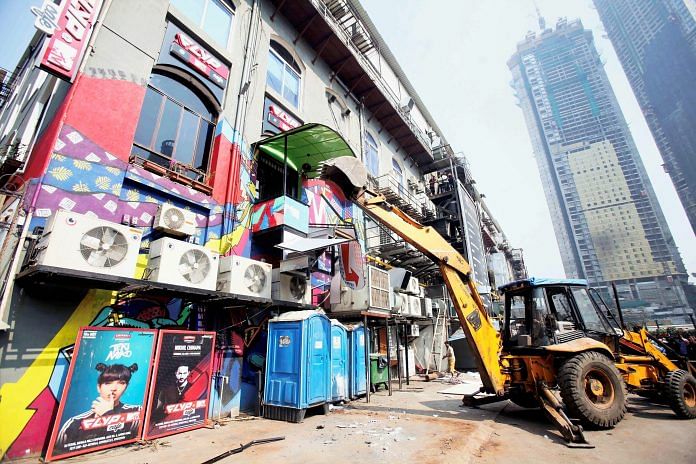Tragedies like the Kamala Mills fire cause outrage against the authorities. But soon, the city moves on to the next tragedy, while callous governance remains.
Fatalism, cynicism and indifference are rapidly taking over the otherwise energetic, vibrant and resilient city of Mumbai.
This sentiment now spans across class barriers.
The inferno in the fashionable upper-class pub at Kamala Mills, killing mostly the young and rich, happened just three months after the fatal stampede on the narrow bridge at the Elphinstone Road suburban station, killing mostly the young but working-class people. This station is very close to Kamala Mills.
Just last month, there was another fire in a small-time farsan and namkeen factory in a distant suburb, in which young boys and workers were charred to death. The working conditions in that unit were truly Dickensian, but did anyone notice? In the pub fire too, there was a young worker from Odisha who perished, but was not considered worth the attention by the media.
On the suburban railway tracks, about four thousand persons die every year, most of them working class. They die falling off the train because of the huge crowds in the compartments, or while crossing the railway lines.
There are hundreds and thousands of chawls in the city, old and dilapidated, as well as some poorly constructed buildings. In the monsoon season, some of them collapse. The residents, generally lower-middle or working class, know that the building is on the verge of collapse, but live there despite warnings because there is nowhere else to go.
All these accidents, which kill the rich, the middle class and the poor, make headlines, and are followed by outrage against the municipal corporation and the political class. But soon, the city moves on to the next tragedy. In the interregnum, the mythical and legendary resilience of the Mumbaikars, which passes off as the so-called “spirit of Mumbai”, is invoked. This spirit of resilience is supposed to be a classless phenomenon in a city defined by class hierarchies.
Neither the glamour of Bollywood, nor the brouhaha of the Sensex, nor the roar of the Thackerays really reflects life in Mumbai. The so-called “animal spirit” of the neo-liberal cartels in the market is quite different from the animal spirit that drives Mumbaikars’ lives. This truly ugly expression is frighteningly manifested in the overcrowded railway stations and the chaos on the roads. The rising number of cars (700 per day) and shrinking road space (not helped by the fact that they are dug up everywhere) make commuting an adventure.
A leading doctor fell into an open drain and died; another international chess coach fell into a ditch and was hit by a following truck. Death is indeed a “many splendoured” reality of life in Mumbai.
A completely insensitive bureaucracy, callous governance, the vulgar consumerism of the upper middle class, fattened over the last decade by pay commissions; the astronomical, black money-boosting prices for residential flats, the MBA-trained youth with its “killer instinct” ideology, and growing hyper-individualism among men and women (masquerading as empowerment in the upper class) has given rise to a kind of socio-cultural disruption.
The lumpenisation of the city began nearly three decades ago. But then it was limited to self-styled senas and small-time mafia.
By and large, the middle class (inhabiting the cooperating housing societies) in their one or two BHKs provided the cultural spine to the city. Vijay Tendulkar and Shyam Benegal, Kishori Amonkar or Kumar Gandharva, the National Centre for the Performing Arts and Prithvi Theatre, the Ravindra Natya Mandir and Shanmukhananda Hall shaped the aesthetic ethos of Mumbai.
Nowadays, no cultural event is possible without hefty sponsorship. When a decent corporate sponsor is not found, in come builders and contractors and the neo-rich, with contacts and accounts in Dubai.
The middle class was cosmopolitan and tolerant, liberal and secular in character. But with the rise in the aggressive Hindutva ideology, coupled with rapidly rising incomes, even this middle class has begun to develop lumpen tendencies. The self-centred life, inflamed further by the smart phones and WhatsApp echo chambers, has made this liberal, argumentative, but social and otherwise frugal middle class intolerant. Now, even the drawing room discussions or dinner table conversations are echoes and mirror images of the TV panel debates—loud, incoherent, abusively communal, and non-conversational monologues.
Of course, all this degeneration has not led to the Kamala Mills fire or the Elphinstone bridge stampede. But the growing indifference and monetary hedonism has radically changed the vibrant and lively character of Mumbai, and transformed the metropolis into a jungle with man-eaters all around.







Why this Kolaveri da?
I would like to believe that the dinner time conversations are still about the issues that matter to decent, middle class families all over the world, have not been coarsened to reflect communalism or negativity.